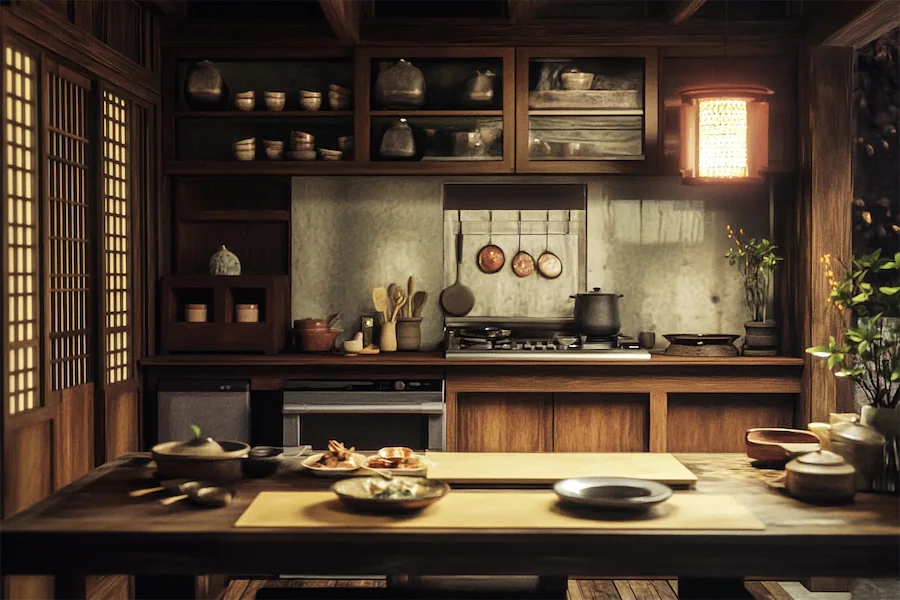An Asian-inspired kitchen embodies the principles of simplicity, harmony, and a deep connection to nature, drawing from the rich design traditions of various Asian cultures. This article explores the key features, applications, and considerations when designing an Asian-inspired kitchen.
Introduction to Asian-Inspired Kitchens
Asian-inspired kitchens emphasize minimalism, natural materials, and a serene ambiance. They often incorporate elements such as clean lines, open spaces, and a balanced color palette to create a tranquil and functional cooking environment.
Key Features of Asian-Inspired Kitchens
Asian-inspired kitchens are distinguished by several hallmark features:
- Natural Materials: Utilization of wood, bamboo, stone, and other natural materials to bring warmth and texture to the space. For example, wooden cabinetry and stone countertops are common choices.
- Minimalist Design: Emphasis on uncluttered spaces with clean lines and simple forms, promoting a sense of calm and order. This often involves integrated appliances and concealed storage solutions.
- Neutral Color Palette with Bold Accents: Incorporation of neutral tones such as whites, grays, and earth tones, complemented by bold accents like red or black to add depth and interest. For instance, red is a strongly symbolic color in many Asian cultures, signifying happiness and good fortune.
- Open Layouts: Designs that facilitate easy movement and flow, often featuring open floor plans that integrate the kitchen with adjacent living spaces. This openness enhances the sense of space and promotes social interaction.
- Zen Elements: Inclusion of features that evoke tranquility, such as indoor plants, water features, or shoji screens, to create a peaceful atmosphere. These elements contribute to a harmonious and balanced environment.
Applications of Asian-Inspired Kitchens
The versatility of Asian-inspired kitchen designs allows them to be adapted to various settings:
- Urban Apartments: Maximizing limited space with efficient layouts and multifunctional furniture pieces that reflect minimalist principles. For example, incorporating space-saving solutions like built-in appliances and compact storage.
- Suburban Homes: Creating open-plan kitchens that serve as the heart of the home, fostering family interaction and a sense of harmony. This can involve integrating dining and cooking areas to facilitate communal activities.
- Eco-Friendly Residences: Utilizing sustainable materials and energy-efficient appliances to align with environmental considerations inherent in many Asian design philosophies. For instance, using bamboo, a rapidly renewable resource, for flooring or cabinetry.
Considerations When Choosing an Asian-Inspired Kitchen
When planning an Asian-inspired kitchen, consider the following:
- Cultural Authenticity: Incorporate design elements that are true to specific Asian cultures to maintain authenticity and respect for traditions. Researching traditional designs can provide inspiration and guidance.
- Functionality: Ensure that the kitchen layout and features meet modern needs while preserving the minimalist aesthetic. This includes considering workflow efficiency and ergonomic design.
- Lighting: Balance natural and artificial lighting to highlight architectural features and create a warm ambiance. Incorporating large windows or skylights can enhance natural light, while strategically placed fixtures can provide adequate task lighting.
- Personal Touches: Add decor that reflects your style while staying true to Asian design principles, such as traditional ceramics, artwork, or textiles. These personal elements can add character and make the space uniquely yours.
Conclusion
Asian-inspired kitchens offer a harmonious blend of functionality, simplicity, and tranquility. By incorporating natural materials, minimalist design, and thoughtful cultural elements, you can create a kitchen space that is both practical and serene, reflecting the timeless beauty of Asian design traditions.
